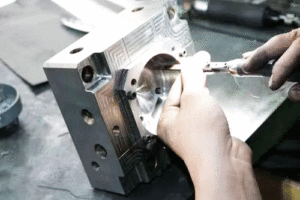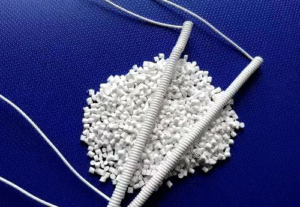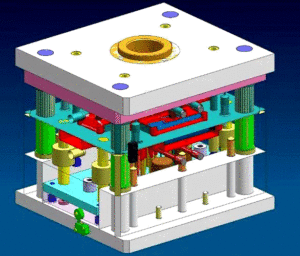
Polishing Treatment for Plastic Molds
Polishing Treatment for Plastic Molds With the widespread application of plastic products, such as daily-use items and beverage packaging containers, there is often a requirement
PC plastics, even touching a bit of water, the situation of bonds broken for hydrolysis, lower molecular weight and lower physical strength will occur. Therefore, before molding, the moisture of polycarbonate should be strictly controlled below 0.02% to avoid the reduced mechanical strength of the molded product or the abnormal appearance of bubbles and silver streaks on the surface.
PC is extremely sensitive to water, so it must be fully dried before injection to reduce its water content to below 0.02%. General PC drying conditions: 100 ~ 120 ℃, at least 4 hours.
The injection temperature must take the shape, size, mold structure, product performance, requirements and other aspects into consideration.
Generally, the temperature used in molding is between 270 and 320 ° C. If the material temperature is too high like exceeding 340 ° C, the PC will decompose, the product will become darker in color, and defects such as silver filaments, dark streaks, black spots, bubbles, etc. At the same time, the physical and mechanical properties also significantly decreased.
PC is also very sensitive to temperature. Melt viscosity decreases significantly with increasing temperature. The barrel temperature is generally at 250 ~ 320 ℃ (better not more than 350 ℃). Properly increasing the barrel temperature is good for PC plasticization. When necessary, internal stress should be annealed, with oven temperature 125 ~ 135 ℃, for 2 hours and naturally cooled to room temperature.
It has a certain influence on the physical and mechanical properties of PC products, internal stress, molding shrinkage rate, etc. It has a greater impact on the appearance and release of the product.The injection pressure which is too low or too high will cause certain defects in the product. Generally the injection pressure is controlled at between 80-120MPa. For thin-walled, long-flow, complex-shaped products with small gates, in order to overcome the resistance of the melt flow and fill the mold cavity in time, the higher injection pressure (120 -145MPa) should be applied. Thus, a complete and smooth surface product is produced.
Poor fluidity requires high-pressure injection, but it needs to take into account the large internal stress remaining on the plastic parts (which may cause cracking).
Injection speed: medium speed should be taken in thick wall , high speed taken in thin wall.
The strength of the holding pressure and the length of the holding time have a great impact on the internal stress of the PC product. The small holding pressure and small shrinkage effect will easily cause the vacuum bubble or the shrunken surface. If the holding pressure is too large, It easily get some large internal stress around the mouth. High material temperature and low holding pressure are often applied in actual processing.
The choice of holding time should take into account the thickness of the product, gate size, mold temperature, etc. Generally, small and thin products do not require a long holding time. On the contrary, the holding time of large and thick products should be longer. The length of dwell time can be determined by the sealing time test of gate.
It has no obvious effect on the performance of PC products. Except thin-walled, small gate, deep hole and long-flow products, medium or slow processing is generally used. Multi-stage injection will be the best which generally in a way of slow-fast-slow.
Mold temperature control: 85 ~ 120 ℃, generally controlled at 80-100 ℃. For products with complex and thin shapes, and higher requirements, it can also be increased to 100-120 ℃, but can not exceed the mold thermal deformation temperature. With the high mold temperature, the temperature difference between mold and PC material can be reduced and also the internal stress of parts.
Due to the high viscosity of the PC melt, to faciliate the plasticizing, exhaust, the maintenance of plastic machine and prevent the screw load from being too large, the speed of the screw mustn’t be too high. It’s generally controlled at 30-60r / min. And the back pressure should be controlled between 10-15% of the injection pressure.
The use of release agent should strictly be controled in the PC injection molding process. At the same time, the use of recycled materials can not exceed three times and the amount should be about 20%.
1) The design of the flow channel should be as thick and short with few bending positions as possible. Also, the round cross-section flow channel and ground and polished flow channel can reduce the flow resistance of the melt.
2) Any type of gate can be used for the injection gate, but the diameter of the water inlet can not less than 1.5mm.
1) The maximum injection volume of products (including flow channels, gates, etc.): should not exceed 70-80% of the nominal injection volume;
2) Clamping pressure: 0.47 to 0.78 tons per square centimeter of the projected area of the finished product (or 3 to 5 tons per square inch);
3) Machine size: The best weight of the finished product is about 40 to 60% of the capacity of the injection molding machine. For example, when the machine expresses its capacity (ounce) in polystyrene, it needs to be reduced by 10%. 1 ounce = 28.3 grams
4) Screw: The screw length should be at least 15 diameters long, and its L / D best is 20: 1. The compression ratio is preferably 1.5: 1 to 30: 1. The check valve at the front end of the screw should be of slip ring type, and its resin flowable gap should be at least 3.2MM.

Polishing Treatment for Plastic Molds With the widespread application of plastic products, such as daily-use items and beverage packaging containers, there is often a requirement

Injection Molding Techniques for TPE and TPR Injection Molding Techniques for TPE and TPR 1. Dry the TPE and TPR material before injection molding It

Winter Maintenance Measures for Injection Molding Machines As winter approaches and temperatures gradually drop, a cold chill envelops the earth. While ensuring personal warmth, it

Assessment Regulations for Mold Trial Exceeding 3 Times Assessment Regulations for Mold Trial 1. Purpose The purpose of this regulation is to standardize the work of